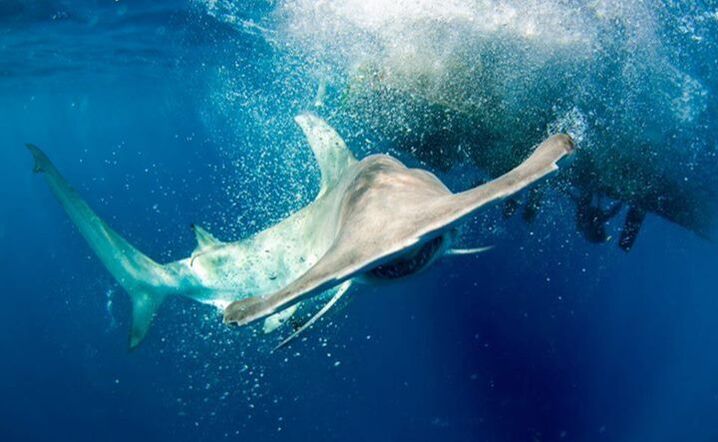|
Ground-breaking New Study Finds Global Abundance Down 71% and 77% of species threatened PRESS RELEASE | January 27, 2021
“We demonstrate that — despite ranging farther from land than most species — oceanic sharks and rays are at exceptionally high risk of extinction, much more so than the average bird, mammal or frog,” said Dr. Nicholas Dulvy, Professor at Simon Fraser University. “Overfishing of oceanic sharks and rays jeopardizes the health of entire ocean ecosystems as well as food security for some of the world’s poorest countries.” Some formerly abundant, wide-ranging shark species have declined so steeply that they are now fall into the two highest threat categories on the IUCN Red List. For example, the commercially valuable Shortfin Mako Shark was recently classified as Endangered while the iconic Oceanic Whitetip Shark is now considered Critically Endangered. The authors calculate for oceanic sharks and rays two indicators for quantifying progress toward the 2020 United Nations Aichi Biodiversity Targets. “Oceanic sharks and rays are vital to the health of vast marine ecosystems, but because they are hidden beneath the ocean surface, it has been difficult to assess and monitor their status,” said Nathan Pacoureau, lead author and postdoctoral Fellow based at Simon Fraser University. “Our study represents the first global synthesis of the state of these essential species at a time when countries should be addressing insufficient progress toward global sustainability goals. While we initially intended it as a useful report card, we now must hope it also serves as an urgent wake-up call.” Sharks and rays are exceptionally susceptible to overfishing because they tend to grow slowly and produce few young. They are sought for meat, fins, liver oil, gill plates, and recreation (fishing and diving). Overexploitation of oceanic sharks and rays has far outpaced effective resource management. Governments have fallen short in fulfilling their wildlife treaty obligations to protect threatened species and end unsustainable international trade in their parts. The regional bodies that manage international fisheries for oceanic fish have poor records for heeding scientific advice and have not prioritized shark and ray protection. “Our analysis is generally grim, but there is hope to be found in a few shark conservation success stories,” said Sonja Fordham, President of Shark Advocates International, a project of The Ocean Foundation. “We document rebuilding for several Northwest Atlantic species, including Great White Sharks and Hammerheads, achieved through science-based fishing limits. Relatively simple safeguards can help to save sharks and rays, but time is running out. We urgently need conservation action across the globe to prevent myriad negative consequences and secure a brighter future for these extraordinary, irreplaceable animals.” MediaMedia contact: Patricia Roy, [email protected], tel. +34 696 905 907. Notes to Editors: The Global Shark Trends Project (GSTP) is a collaboration of the IUCN Shark Specialist Group, Simon Fraser University, James Cook University, and the Georgia Aquarium established with support from the Shark Conservation Fund to assess the extinction risk for chondrichthyan fishes (sharks, rays, and chimaeras). The GSTP team engaged more than a dozen additional experts from around the world to complete the oceanic shark and ray analysis. Download the press release here. ReferencePacoureau, N., Rigby, C.L., Kyne, P.M. et al. Half a century of global decline in oceanic sharks and rays. Nature 589, 567–571 (2021). doi.org/10.1038/s41586-020-03173-9 Featured in...Comments are closed.
|












 RSS Feed
RSS Feed